The concepts covered in this fact sheet go beyond those seen in high school. It is intended as a supplement for those who are curious to learn more.
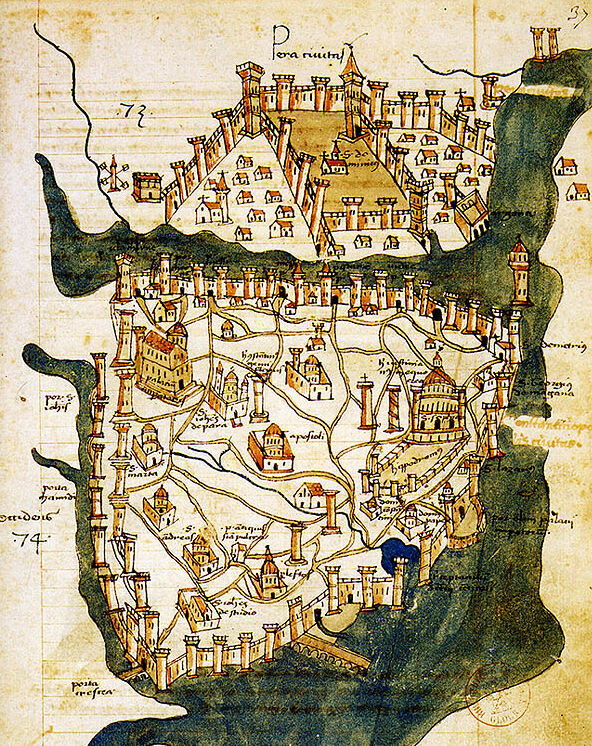
Map of Constantinople (1422), by Cristoforo Buondelmonti.
Constantinople (formerly Byzantium) has a long history. This great city passed through the hands of various empires. By controlling this important city, conquerors were able to benefit from its wealth and flourishing trade. Constantinople owes its commercial strength to its advantageous geographical position.
The city was located on a peninsula in the Bosphorus Strait. This passage links the Black Sea with the Sea of Marmara. This inland sea gives access to the Aegean and then the Mediterranean.
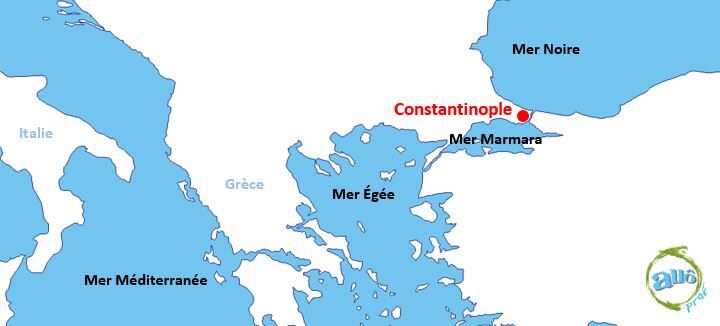
Constantinople's geographical location.
Note : An image in English is coming soon.
To the east, routes from Constantinople could reach both the Middle East and Asia (India, China, etc.).
Situated on the border between East and West, Constantinople was able to benefit from the riches of Asia, Africa and Europe. It also played an important commercial role, since goods destined for the European market first had to transit through Constantinople.
In addition to being a strategic artery for trade relations, Constantinople's geographical position gave it great military strength. Indeed, its location on a peninsula in the Bosphorus strait meant that it could defend itself more easily on all fronts.
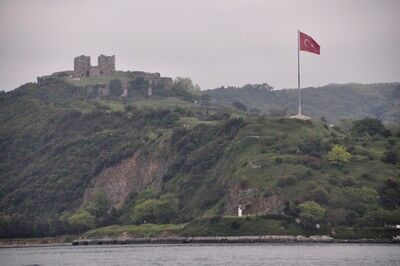
The fortress of Yoros was located at the meeting point of the Bosphorus and the Black Sea.
For the same reasons, Constantinople's position favored territorial expansion. Troops could easily move to any region. Constantinople's geographical position explains why it was so rich and powerful. In fact, it was this very fact that attracted the covetousness of outlying countries.
The first inhabitants to found a city here were Greek settlers in 667 BC. Named after a king, Byzantium grew rapidly thanks to the advantages of its position in both Europe and Asia, sailing both the Mediterranean and the Black Sea. Coveted by many, it was repeatedly plundered and destroyed by various invaders. Byzantium's prosperity was based on the presence of merchants, traders and numerous trading posts.
By the 4th century, Byzantium belonged to the Roman Empire. However, barbarian invasions had reduced the size of the empire in earlier centuries. The arrival of Constantine1st as emperor brought a new period of stability to the empire. The new emperor decided to name Byzantium the new capital of the empire. Already a major city with a 1,000-year history, Byzantium's geographical position made it an ideal gateway between Europe and Asia.
The subsequent development of Byzantium and the presence of the empire's wealthiest officials helped to shift the center of the Roman Empire eastwards. Rome was gradually losing its influence and prestige. The city's inhabitants enjoyed virtually the same privileges as those in Rome: exemption from taxes, free distribution of wheat, creation of a senate. On Constantine's death, the city was renamed Constantinople in his honor.
By the time Constantine chose Byzantium as his capital, Christianity was gaining ground in Europe. Constantine was the first Roman emperor to convert to Christianity. The new Rome became an almost exclusively Christian city, with few pagan temples. The new capital also heralded the new religious identity of the Roman Empire. The city developed by integrating Greek and Roman culture with the new Christian culture. Constantinople soon became the new center of the Roman Empire and the center of the Christian religion.
In 395, the Roman Empire was divided in two: the Eastern Roman Empire to the east and the Western Roman Empire to the west. Constantinople continued its development, being recognized as the capital of the Eastern Roman Empire.

Map of Constantinople during the Eastern Roman Empire.
Note : An image in English is coming soon.
In the 6th century, Constantinople had a population of no less than one million. This period is considered Constantinople's heyday. In fact, it was during this period that Emperor Justinian built the Basilica of Saint Sophia, a masterpiece of Byzantine art.
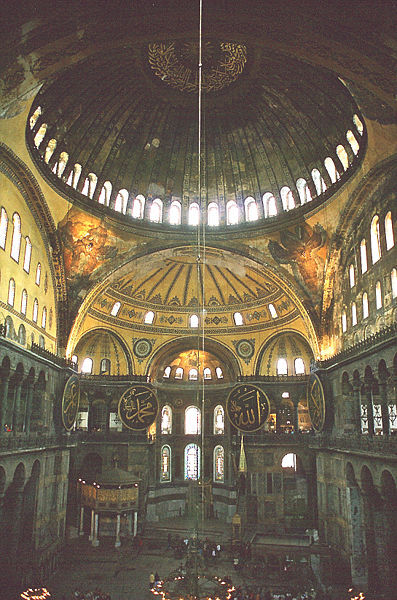
Inside the Basilica of Saint Sophia (turned into a museum in 1935).
Byzantium soon found itself in the path of the expanding Arab Empire. The Arab army made several attempts to take possession of the great city. The Byzantine army had to defend the city ardently. Byzantium was strongly protected by its walls and enclosures. In 674, however, these did not prevent the Arab army from laying siege to the city. Resisting the siege for four years, the city managed to drive the Arabs out in 678. The Byzantine weapon, Greek fire, a highly flammable mixture that the Byzantines threw at Arab ships, helped repel the enemy.
In 717, the Arab army again attempted to take possession of the city. This time, the Arabs held the siege for only a year before turning back, their defeat once again attributable to Greek fire, but also to plague and famine.
Between the 9th and 12th centuries, Byzantium enjoyed a period of strong growth. This growth was strongly linked to the increase in commercial activity in Europe. With the Great Trade resuming at the same time, the Byzantines benefited from exchanges between Europeans and the rest of the Orient. Byzantium was then frequented by Italian and Arab merchants carrying loads of spices and silk.
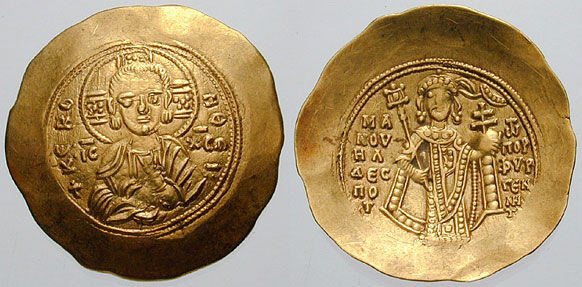
Coin from Constantinople in the 11th century, during the reign of Emperor Manuel I Comnenus.
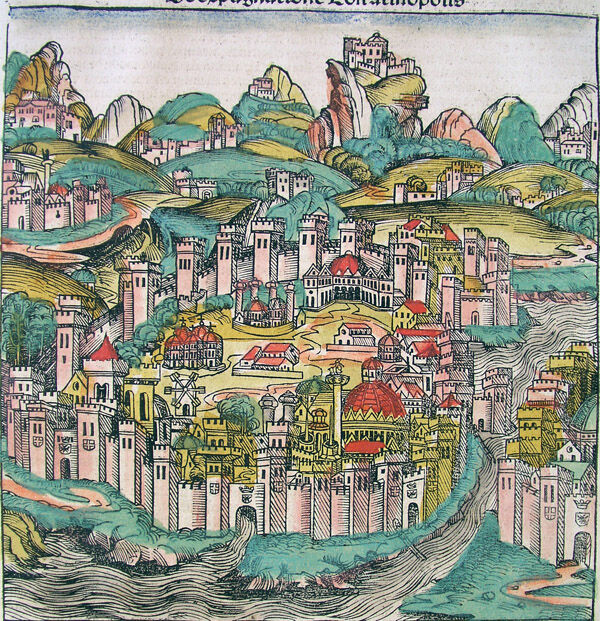
Byzantium in the Middle Ages.
In 1082, the Byzantines concluded a trade agreement with the Venetians. In exchange for the lifting of customs tariffs, Venice guaranteed military aid in the event of threat or war.
Under threat from the Turkish army, whose territory was expanding all the time, Byzantium set about forging stronger ties with Western countries. It was Byzantium's call for help in defending itself against the Turks that led to the first Crusades. Venetian and Genoese merchants took advantage of the situation to seize control of the trade. This action, which aroused the frustration of the Byzantines, led to a massacre in the Italian quarter of Byzantium in 1182.
The first popular crusade took place in Byzantium in 1096. The crusaders were greatly impressed by the sight of the most beautiful city in the world at the time. Several crusades followed, but the one that had the greatest impact on Byzantium was undoubtedly the fourth. In 1203, several knights set out for the Byzantine capital and took control of the city. A number of Italian crusaders took part in this operation in revenge for the massacre of 1182. Knights from all over Europe helped the Venetians in exchange for the transport they had been offered.
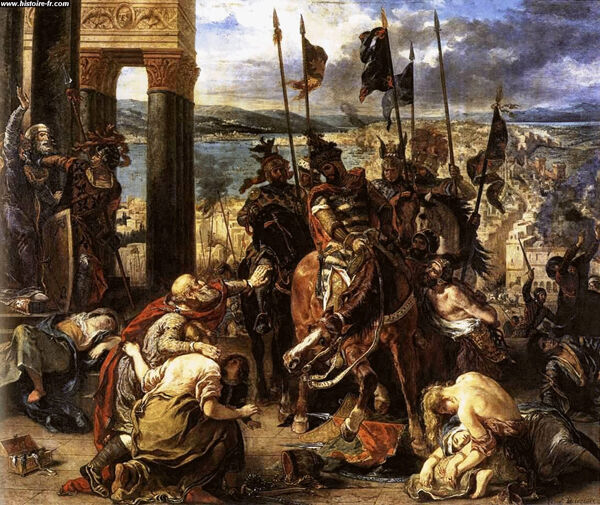
The Taking of Constantinople by Eugène Delacroix.
The Crusaders took possession of the town, looting and burning it to the ground. The population was also massacred. The Byzantines were only able to regain possession of their city in 1261, thanks to the support of the Genoese army, an enemy of the Venetian army.
In the meantime, the Ottoman threat was growing stronger, a threat that hung over the city already weakened by the numerous crusades. However, the Byzantine Empire persisted in refusing Western aid. On the other hand, Western countries were ambivalent about lending Byzantium a helping hand. Would they prefer to help the capital fight the Muslims, or would they rather have the pleasure of seeing the Orthodox city fall and lose influence? Byzantium fought alone against the mighty Ottoman Empire. The city was quickly taken and invaded.
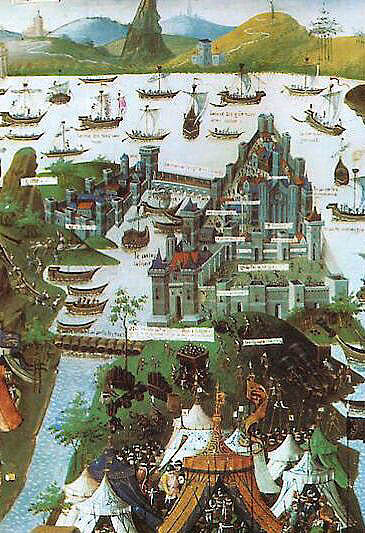
The siege of Constantinople in 1453.
In 1453, Byzantium was forced to lay down its arms to the Ottoman army. The city was invaded, and the Muslims began the Islamization of the city, first transforming the Basilica of Saint Sophia into a mosque. The new Ottoman capital, renamed Istanbul, remained the center of Oriental trade. On the strength of this victory, the Ottoman Empire even attempted to continue its expansion in Europe by laying siege to Vienna.
During the 16th century, Istanbul was at the heart of the development of Ottoman art. The Mosque of Suleiman the Magnificent and the Blue Mosque bear witness to this cultural renewal. Ottoman culture also led to the development of bridges and aqueducts.
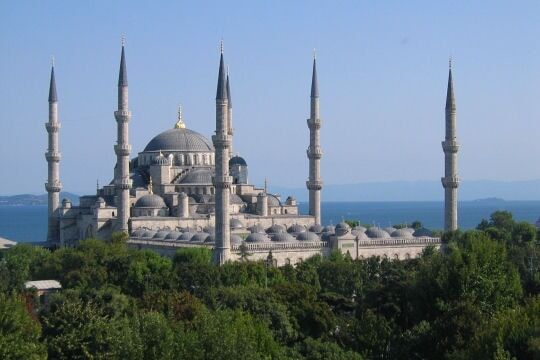
The Blue Mosque.
The Ottoman Empire maintained its power until the 18th century, when several civil wars and unrest weakened it. On the other hand, Western powers were ready to attack the empire, which had become vulnerable due to its internal ills. Western countries took possession ofIstanbul and set about modernizing the city between 1861 and 1922: electricity, stations, railroads and more. Many travelers could now visit this historic city with the arrival of the Orient Express, a luxurious train.

Istanbul at the end of the 19th century.
In 1923, the city was officially renamed Istanbul, a name it still bears today, but Ankara became Turkey's capital.

Ankara today.
At the start of the Byzantine Empire in the 4th century, cities functioned exactly as they had in the Roman Empire. The situation changed somewhat with the rise of Christianity. Religion took on an increasingly important role in the Byzantine Empire. For example, coins were no longer minted with imperial symbols, but rather with Christian symbols: the face of Christ, the face of the Virgin Mary, the cross, etc.
The emperor ruled according to the principles of the Christian faith. He even saw himself as God's representative on earth, to whom we owed respect and obedience. On the other hand, many emperors lost their power under the pretext that they did not sufficiently respect the dogmas and values of Christianity. Economically, the young Byzantine Empire was very stable, as evidenced by its currency, whose value did not decline until the 11th century. This prosperous economy was based on trade - the wheat trade, the silk trade and so on.
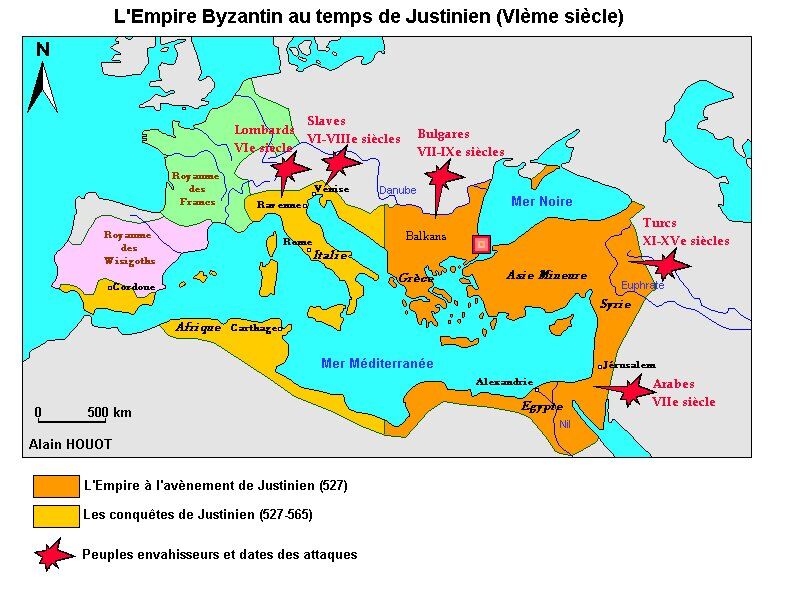
The Byzantine Empire in the 5th century.
Note : An image in English is coming soon.
At the same time, society was experiencing a demographic boom. Growth was constant throughout the 4th and 5th centuries. In the 6th century, however, this increase was curbed by numerous natural disasters and the invasion of the Persians.
Intellectual life was important: Greek culture was preserved and valued. Indeed, the Byzantines set out to collect as many Greek literary and philosophical works as possible. In fact, they founded a huge library in Byzantium. This place of culture ensured the survival of Greek values, knowledge and texts.
The empire also boasted several great schools, some of which specialized in certain fields. Important schools still exist, including those in Byzantium, Alexandria, Antioch, Beirut, Edessa and Athens. Children's education consisted mainly of knowledge from the Greeks, the history of the Church Fathers (which replaced ancient philosophy) and the history of the Saints.
Between the 6th and 7th centuries, the Byzantine Empire was repeatedly invaded by Italians, Slavs and Persians. The latter had succeeded in taking possession of several cities and regions: Antioch, Syria, Palestine, Egypt and Asia Minor. It was following these attacks that the Arab Empire turned its attention to the two empires, already weakened by war.
Emperor Heraclius undertook several reforms aimed at modifying the organization and administration of the empire. These included new defense, counter-attack and recruitment measures. It was also during Heraclius' reign that religious unity was achieved in the empire. Without losing Greek influence, Byzantine intellectuals were keen to analyze ancient culture while remaining good Christians.
Arab attacks on Byzantium were all repulsed by Byzantine armies. In the 9th century, the empire entered a new period of development. This time, arms, diplomacy and Christianization missions ensured a better situation for the Byzantine Empire. Emperor Basil II succeeded in regaining possession of several territories. By the 10th century, the territory of the Byzantine Empire had returned to its 7th century size.
The city's finances were based on the numerous taxes that ensured a sufficiently large income. Civil servants were generally well trained to perform their duties properly.
Agriculture was also highly productive. Peasant communities grew wheat, vines and olives. Some also raised sheep and goats. Despite their more rudimentary techniques, their methods were perfectly adapted to the climate. As a result, farmers managed to grow enough crops to sell the surplus.
Byzantium still actively controlled trade. Merchants controlled both the routes to Russia and those to Italy. The capital was then a city of great wealth, attracting the richest elements of society and prompting many craftsmen to produce luxury goods: goldsmiths, silversmiths, ivory makers, textile manufacturers and so on.
In the 9th century, Byzantine intellectuals began to consolidate their knowledge in encyclopedias. Many books of knowledge were written. At the same time, hagiography, i.e. the writing of the lives of saints, was also flourishing.
In 1056, new reforms took place in the empire, resulting in fewer soldiers in the army. Internal struggles over succession also broke out within the empire. The Turkish invasions of the empire began. With the armies unable to repel them, the population lost hope. Defeats added to civil wars.
A new ruler, Alexis, succeeded in repelling the invaders thanks to reforms begun in 1081. The 11th century was then marked by economic recovery, bolstered by trade with the Italians. The schism of 1054, however, put an end to good relations between the Byzantine Empire and the West, until the empire asked for help to slow the Turkish invasions. However, the Byzantine Empire had to repel too many invasions. While the Byzantines defended themselves, European merchants took control of trade.
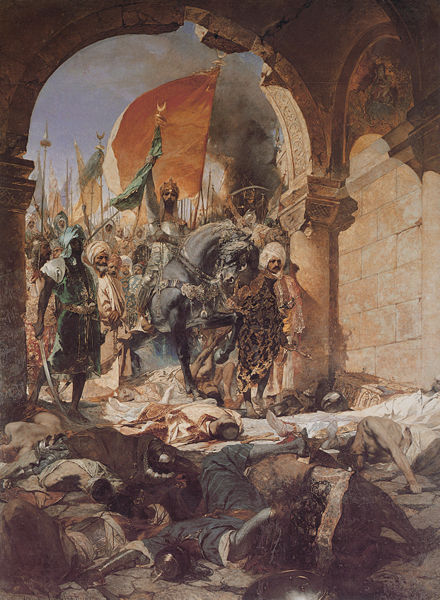
Entrance of the Turks after their victory.
Still under threat from the Turks, the Byzantines once again turned to the West for help. After the failure of the Crusade of 1396, the Byzantine Empire tried in vain to fight the Ottomans until its defeat in 1453. When the Ottomans took Byzantium, Westerners no longer had easy access to goods from the East. This was one of the reasons for the great explorations.
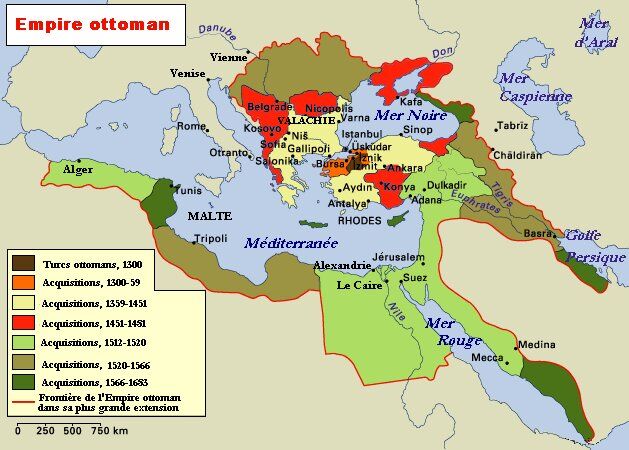
The Ottoman Empire at different periods.
Note : An image in English is coming soon.